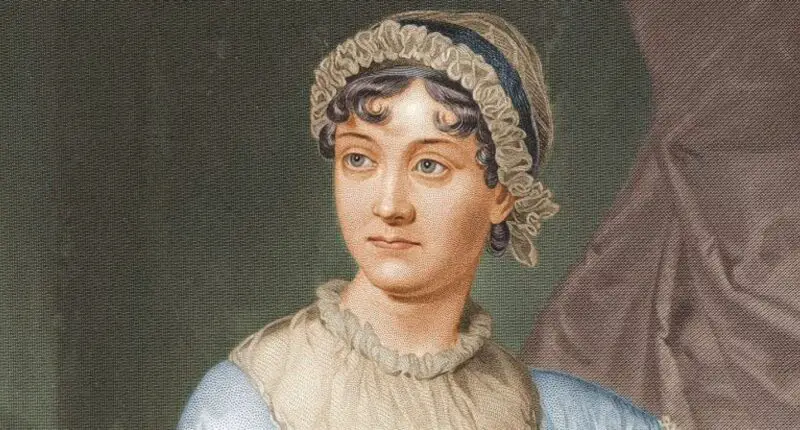Jane Austen Biography: Jane Austen was an English novelist who is widely regarded as one of the greatest writers in the English language. She was born in 1775 in the village of Steventon in Hampshire, England, and was the seventh of eight children. Her father, George Austen, was a rector, and her mother, Cassandra Leigh Austen, was a member of a prominent family. She began writing at a young age, and her first known work is a collection of juvenile writings that she completed when she was just eleven years old.
In her early twenties, Austen began writing her first novels, but they were not published until after her death. Her first published novel was Sense and Sensibility, which appeared in 1811. This was followed by Pride and Prejudice (1813), Mansfield Park (1814), Emma (1815), and Persuasion (1817). These novels are known for their wit, their sharp observations of society, and their exploration of the lives and relationships of women in the early 19th century.
Austen’s novels were not immediately popular, and she struggled to find a publisher for some of her works. However, her reputation grew after her death, and her novels are now considered classics of English literature. Austen never married, and she died at the age of 41 in Winchester, England, in 1817.
Jane Austen – Life and Education
Jane Austen was born on 16 December 1775 in Steventon, Hampshire. Austen’s father George Austen came from a wealthy family of wool merchants. He served as the rector of the parishes of Steventon and Deane. At the age of 16, when he entered St John’s College, Oxford he presumably met Cassandra Leigh. She came from the well-known Leigh family. They married on 26 April 1764.
Jane Austen and her sister were sent to Oxford in 1783 to be educated by Mrs. Ann Cawley. Austen was home educated after she caught typhus and nearly died. In early 1785 she attended boarding school with her sister at the Reading Abbey Girl’s School. Before December of 1786, they came back because the fee for two sisters was too high for the family.
The remainder of Austen’s education came from reading guided by her brothers James and Henry and her father. Apparently, Austen had access to her father’s library and Warren Hastings’s, who was a family friend. An essential aspect of her education was private theatricals. The friends and family staged a series of plays from her early childhood in the rectory barn. Some of the plays are Richard Sheridan’s The Rivals and David Garrick’s Bon Ton. Most of the staged plays were comedies which certainly cultivated Austen’s satirical sense. At the age of 12, she tried to write; Austen wrote three plays during her teenage.
Works and Publication
Like other women writer’s at the time, Austen published her works anonymously. A woman who wished to be a full-time writer was believed to be disgracing her femininity. The ideal roles for a woman were as a mother and wife, and writing was best as a secondary form of activity. Through her brother Henry, publisher Thomas Egerton agreed to publish one of her best novels Sense and Sensibility which like all other Jane Austen novels except Pride and Prejudice was published at the author’s financial risk.
Her novels were published in larger editions, ranging from about 750 copies of Sense and Sensibility to about 2,000 copies of Emma. However, it is unclear whether the decision to print more copies than usual was Austen’s or the publisher’s. She made 140 pounds from Sense and Sensibility which is equivalent to about 10,800 pounds. Then she sold the copyright of Pride and Prejudice to Egerton and the book was an immediate success. In 1814, Egerton published Mansfield Park. All the copies were sold within six months of publication. Her earnings on this novel were larger than her other works. In mid-1815, Austen moved on from Egerton to John Murray, a known London publisher. He published Emma in December 1815 and the second edition of Mansfield Park in 1816.
Jane Austen – Genre and Style
Austen’s works critique the sentimental novels of the second half of the 19th century. In the mid-20th century literary critics, Ian Watt and F. R. Leavis placed Austen in the tradition of the earliest English novelists Richardson and Fielding. They believed that she uses their tradition of realism, satire, and irony to form an author superior to both. Austen distances herself from escapist novels and the innovation and discipline she demonstrates are similar to William Wordsworth. She abstains from popular Gothic fiction in which the heroine is usually stranded in a remote location; although, she alludes to this trope in her novel Northanger Abbey. Instead of denigrating the genre, Austen transforms the setting with modern comforts. Samuel Johnson’s influence is evident in Austen’s works, as she follows his advice to write “a representation of life as may excite mirth”.
Adaptations of Jane Austen’s Works
Jane Austen’s novels have resulted in adaptations, sequels, and prequels of every kind. From the 19th century, her family members published conclusions about her incomplete works. By 2000, there were more than 100 printed adaptations. In 1895, Austen’s first dramatic adaptation, Rosina Filippi’s Duologues, and Scenes from the Novels of Jane Austen: Arranged and Adapted for Drawing-Room Performance was published. Rosina Filippi also staged the first professional adaptation in 1901, The Bennets. The first film adaptation of Pride and Prejudice starring Laurence Oliver and Greer Garson was by the 1940 MGM production. Ang Lee’s Sense and Sensibility was a popular film and for the film, star, and screenwriter Emma Thompson won an Academy Award. Another popular Pride and Prejudice adaptation were of Joe Wright’s 2005 British production starring Keira Knightley and Matthew Macfadyen.
Illness and Death
Jane Austen was feeling unwell by early 1816. However, she neglected the warning signs. By the middle of the same year, her life began to deteriorate. According to her biographer Zachary Cope, the reason for her death is Addison’s disease. Though, the final reason for her death is also said to be the result of Hodgkin’s lymphoma. She continued to work despite her sickness. Austen made light of her illness, defining it as “bile” and rheumatism. As her condition deteriorates, she experienced difficulty in walking and extreme lethargy. By mid-April, Austen was confined to bed. In May, she was brought to Winchester for treatment, by this time she was suffering from agonizing pain. On 18 July 1817, in Winchester Jane Austen welcomed death at the age of 41.
Also Read: How To Make a Daily Journal Explained in 10 Easy Steps



